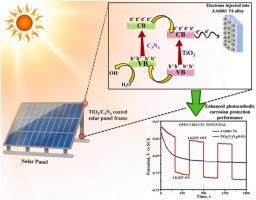采用TiO2/C3N4异质结构制备太阳能板铝骨架的光电阴极腐蚀防护性能
IF 6.3
2区 材料科学
Q2 CHEMISTRY, PHYSICAL
引用次数: 0
摘要
AA6061 T6合金因其重量轻、强度高而广泛应用于太阳能电池板框架。由于太阳能电池板的腐蚀,光伏行业每年遭受约10%的损失。光阴极腐蚀防护技术是解决这一问题最有前途的光电化学技术。本文采用溶胶-凝胶法制备了不同重量百分比C3N4的TiO2,并包被在AA6061 T6上。通过x射线衍射(XRD)、红外光谱(FT - IR)和红外光谱(&)分析了TiO2/C3N4异质结构的结构特性。拉曼分析证实了TiO2与C3N4的协同作用。采用UV-Vis、光致发光(PL)和Mott-Schottky (MS)分析研究了TiO2/C3N4异质结构的光学和电子性质。异质结构的UV-DRS光谱的红移表明带隙能量降低,而抑制的PL强度表明电荷分离得到改善。Mott-Schottky分析显示,TiO2/C3N4异质结构(-0.4 V vs SCE)的平带电位发生了负位移,这证实了改善的电子转移、有效的界面载流子输运能力和良好的能带排列是增强光电阴极保护的重要原因。在光照下,连续两次涂覆TiO2/C3N4 (0.01 g)的AA6061 T6合金的腐蚀电流密度(Icorr)为2.03 × 10⁻26 mA/cm²,与未涂覆的AA6061 T6合金相比,由于TiO2/C3N4异质结构的界面带排列为增强的电子转移提供了途径,腐蚀电流密度降低了78%。这些结果表明,TiO2/C3N4异质结构涂层改善了光生电荷载流子的分离,有利于光电阴极腐蚀保护太阳能电池板框架的实际应用。本研究为开发具有光电阴极保护功能的异质结薄膜提供了有价值的见解。本文章由计算机程序翻译,如有差异,请以英文原文为准。

A photocathodic corrosion protection performance of aluminium frames in solar panels using TiO2/C3N4 heterostructure
AA6061 T6 alloy is widely used in solar panel frames due to its lightweight and high strength. The photovoltaic sector suffers from the annual damages of around 10 % caused by the corrosion of solar panels. The photocathodic corrosion protection is the most promising photoelectrochemical technology to mitigate this issue. Herein, TiO2 with various weight percentages of C3N4 was successfully prepared using the sol-gel method and coated over AA6061 T6. The structure properties of the TiO2/C3N4 heterostructure were extensively scrutinized through the X-ray diffraction (XRD), FT-IR, & Raman analysis confirms that synergic interaction of the TiO2 and C3N4. The optical and electronic properties of the TiO2/C3N4 heterostructure were studied using UV–Vis, photoluminescence (PL), and Mott–Schottky (MS) analyses. A red shift in UV-DRS spectra of the heterostructure indicated reduced band gap energy, while suppressed PL intensity suggested improved charge separation. Mott–Schottky analysis revealed a negative shift in the flat-band potential for the TiO2/C3N4 heterostructure (–0.4 V vs SCE), confirming improved electron transfer, effective interface carrier transport ability and a favorable band alignment is highly responsible for enhanced photocathodic protection. The AA6061 T6 alloy coated with TiO2/C3N4 (0.01 g) through two consecutive depositions exhibited a corrosion current density (Icorr) of 2.03 × 10⁻⁶ mA/cm² under light illumination, achieving a 78 % reduction in corrosion compared to uncoated AA6061 T6 due to their interfacial band alignment of the TiO2/C3N4 heterostructure which provides pathway for the enhanced electron transfer. These results highlight that TiO2/C3N4 heterostructure coating improves the photo-generated charge carrier separation, conducive to the practical application of the solar panel frames by photocathodic corrosion protection. This research provides valuable insights for developing the heterojunction film intending to provide photocathodic protection for metal materials.
求助全文
通过发布文献求助,成功后即可免费获取论文全文。
去求助
来源期刊

Journal of Alloys and Compounds
工程技术-材料科学:综合
CiteScore
11.10
自引率
14.50%
发文量
5146
审稿时长
67 days
期刊介绍:
The Journal of Alloys and Compounds is intended to serve as an international medium for the publication of work on solid materials comprising compounds as well as alloys. Its great strength lies in the diversity of discipline which it encompasses, drawing together results from materials science, solid-state chemistry and physics.
 求助内容:
求助内容: 应助结果提醒方式:
应助结果提醒方式:


